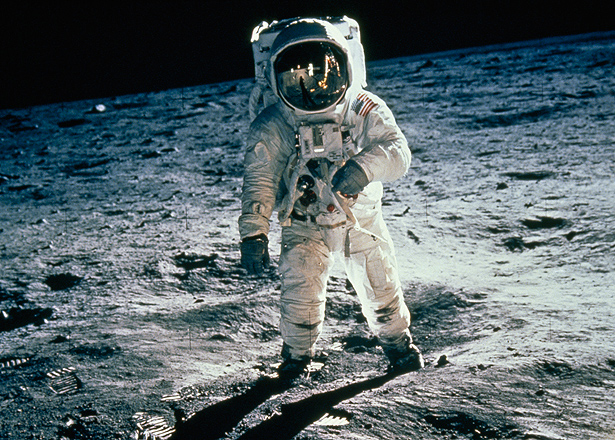
Armstrong walks on moon on July 20, 1969
Armstrong walks on moon: At 10:56 p.m. EDT, American astronaut Neil Armstrong, 240,000 miles from Earth, speaks these words to more than a billion people listening at home: “That’s one small step for man, one giant leap for mankind.” Stepping off the lunar landing module Eagle, Armstrong became the first human to walk on the surface of the moon.
The American effort to send astronauts to the moon has its origins in a famous appeal President John F. Kennedy made to a special joint session of Congress on May 25, 1961: “I believe this nation should commit itself to achieving the goal, before this decade is out, of landing a man on the moon and returning him safely to Earth.” At the time, the United States was still trailing the Soviet Union in space developments, and Cold War-era America welcomed Kennedy’s bold proposal.
In 1966, after five years of work by an international team of scientists and engineers, the National Aeronautics and Space Administration (NASA) conducted the first unmanned Apollo mission, testing the structural integrity of the proposed launch vehicle and spacecraft combination. Then, on January 27, 1967, tragedy struck at Kennedy Space Center in Cape Canaveral, Florida, when a fire broke out during a manned launch-pad test of the Apollo spacecraft and Saturn rocket. Three astronauts were killed in the fire.
Despite the setback, NASA and its thousands of employees forged ahead, and in October 1968, Apollo 7, the first manned Apollo mission, orbited Earth and successfully tested many of the sophisticated systems needed to conduct a moon journey and landing. In December of the same year, Apollo 8 took three astronauts to the dark side of the moon and back, and in March 1969 Apollo 9 tested the lunar module for the first time while in Earth orbit. Then in May, the three astronauts of Apollo 10 took the first complete Apollo spacecraft around the moon in a dry run for the scheduled July landing mission.
At 9:32 a.m. on July 16, with the world watching, Apollo 11 took off from Kennedy Space Center with astronauts Neil Armstrong, Edwin Aldrin Jr., and Michael Collins aboard. Armstrong, a 38-year-old civilian research pilot, was the commander of the mission. After traveling 240,000 miles in 76 hours, Apollo 11 entered into a lunar orbit on July 19. The next day, at 1:46 p.m., the lunar module Eagle, manned by Armstrong and Aldrin, separated from the command module, where Collins remained. Two hours later, the Eagle began its descent to the lunar surface, and at 4:18 p.m. the craft touched down on the southwestern edge of the Sea of Tranquility. Armstrong immediately radioed to Mission Control in Houston, Texas, a famous message: “The Eagle has landed.”
At 10:39 p.m., five hours ahead of the original schedule, Armstrong opened the hatch of the lunar module. As he made his way down the lunar module’s ladder, a television camera attached to the craft recorded his progress and beamed the signal back to Earth, where hundreds of millions watched in great anticipation. At 10:56 p.m., Armstrong spoke his famous quote, which he later contended was slightly garbled by his microphone and meant to be “that’s one small step for a man, one giant leap for mankind.” He then planted his left foot on the gray, powdery surface, took a cautious step forward, and humanity had walked on the moon.
“Buzz” Aldrin joined him on the moon’s surface at 11:11 p.m., and together they took photographs of the terrain, planted a U.S. flag, ran a few simple scientific tests, and spoke with President Richard M. Nixon via Houston. By 1:11 a.m. on July 21, both astronauts were back in the lunar module and the hatch was closed. The two men slept that night on the surface of the moon, and at 1:54 p.m. the Eagle began its ascent back to the command module. Among the items left on the surface of the moon was a plaque that read: “Here men from the planet Earth first set foot on the moon–July 1969 A.D–We came in peace for all mankind.”
At 5:35 p.m., Armstrong and Aldrin successfully docked and rejoined Collins, and at 12:56 a.m. on July 22 Apollo 11 began its journey home, safely splashing down in the Pacific Ocean at 12:51 p.m. on July 24.
There would be five more successful lunar landing missions, and one unplanned lunar swing-by, Apollo 13. The last men to walk on the moon, astronauts Eugene Cernan and Harrison Schmitt of the Apollo 17 mission, left the lunar surface on December 14, 1972. The Apollo program was a costly and labor intensive endeavor, involving an estimated 400,000 engineers, technicians, and scientists, and costing $24 billion (close to $100 billion in today’s dollars). The expense was justified by Kennedy’s 1961 mandate to beat the Soviets to the moon, and after the feat was accomplished ongoing missions lost their viability.
History Channel / Wikipedia / Encyclopedia Britannica / NASA /
Smithsonian National Air and Space.edu / Linar and Planetary Institute.edu / Space.com /
Apollo 11 (YouTube search) 
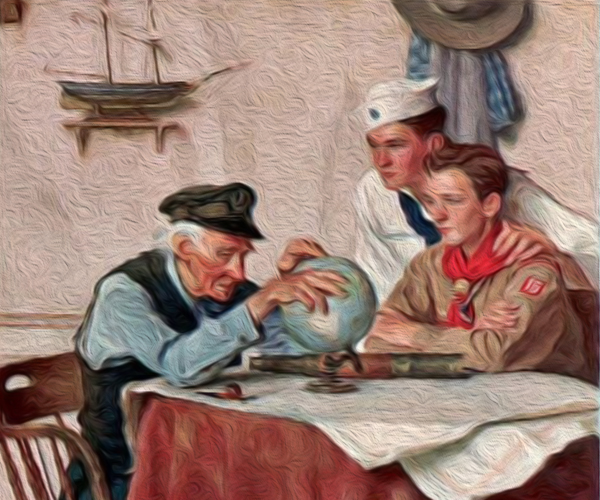
Understanding Military Terminology - Medical logistics support
(DOD) A functional area of logistics support for the joint force surgeon’s health service support mission and that includes supplying Class VIII medical supplies (medical material to include medical peculiar repair parts used to sustain the health service support system), optical fabrication, medical equipment maintenance, blood storage and distribution, and medical gases. Also called MEDLOG support.
Joint Publications (JP 4-02) (Health Service Support - Defense Technical Information Center)
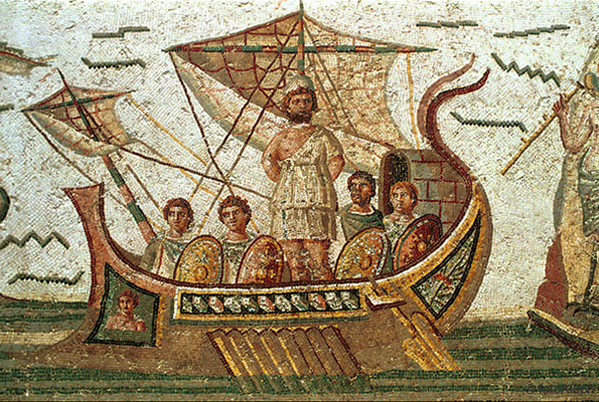
The Old Salt’s Corner
“The Odyssey”
BOOK XI
Then, when we had got down to the sea shore we drew our ship into the water and got her mast and sails into her; we also put the sheep on board and took our places, weeping and in great distress of mind. Circe, that great and cunning goddess, sent us a fair wind that blew dead aft and stayed steadily with us keeping our sails all the time well filled; so we did whatever wanted doing to the ship's gear and let her go as the wind and helmsman headed her. All day long her sails were full as she held her course over the sea, but when the sun went down and darkness was over all the earth, we got into the deep waters of the river Oceanus, where lie the land and city of the Cimmerians who live enshrouded in mist and darkness which the rays of the sun never pierce neither at his rising nor as he goes down again out of the heavens, but the poor wretches live in one long melancholy night. When we got there we beached the ship, took the sheep out of her, and went along by the waters of Oceanus till we came to the place of which Circe had told us.
“Here Perimedes and Eurylochus held the victims, while I drew my sword and dug the trench a cubit each way. I made a drink-offering to all the dead, first with honey and milk, then with wine, and thirdly with water, and I sprinkled white barley meal over the whole, praying earnestly to the poor feckless ghosts, and promising them that when I got back to Ithaca I would sacrifice a barren heifer for them, the best I had, and would load the pyre with good things. I also particularly promised that Teiresias should have a black sheep to himself, the best in all my flocks. When I had prayed sufficiently to the dead, I cut the throats of the two sheep and let the blood run into the trench, whereon the ghosts came trooping up from Erebus- brides, young bachelors, old men worn out with toil, maids who had been crossed in love, and brave men who had been killed in battle, with their armour still smirched with blood; they came from every quarter and flitted round the trench with a strange kind of screaming sound that made me turn pale with fear. When I saw them coming I told the men to be quick and flay the carcasses of the two dead sheep and make burnt offerings of them, and at the same time to repeat prayers to Hades and to Proserpine; but I sat where I was with my sword drawn and would not let the poor feckless ghosts come near the blood till Teiresias should have answered my questions.”
“The first ghost 'that came was that of my comrade Elpenor, for he had not yet been laid beneath the earth. We had left his body unwaked and unburied in Circe's house, for we had had too much else to do. I was very sorry for him, and cried when I saw him: 'Elpenor,' said I, 'how did you come down here into this gloom and darkness? You have here on foot quicker than I have with my ship.' ”
“ 'Sir', he answered with a groan, 'it was all bad luck, and my own unspeakable drunkenness. I was lying asleep on the top of Circe's house, and never thought of coming down again by the great staircase but fell right off the roof and broke my neck, so my soul down to the house of Hades. And now I beseech you by all those whom you have left behind you, though they are not here, by your wife, by the father who brought you up when you were a child, and by Telemachus who is the one hope of your house, do what I shall now ask you. I know that when you leave this limbo you will again hold your ship for the Aeaean island. Do not go thence leaving me unwaked and unburied behind you, or I may bring heaven's anger upon you; but burn me with whatever armour I have, build a barrow for me on the sea shore, that may tell people in days to come what a poor unlucky fellow I was, and plant over my grave the oar I used to row with when I was yet alive and with my messmates.' And I said, 'My poor fellow, I will do all that you have asked of me.' ”
BOOK XI continued ...
~ Homer
Written 800 B.C.E
Translated by Samuel Butler
Table of Contents

“I’m Just Sayin”
“A hospital bed built is a bed filled.”
~ Roemer's law

“Thought for the Day”
“Whatever is my right
is also the right of another;
and it becomes my duty to guarantee
as well as possess.”
~ Thomas Paine Rights of Man: Part 1, 1791

“What I Have Learned”
“Sometimes the smallest step in the right direction
ends up being the biggest step of your life.”
~ Anonymous

Bizarre News (we couldn’t make up stuff this good – real news story)

Forensic scientists caught a deer munching on a human carcass for the first time ever
Warning: the photos below may be disturbing for some people.
In July 2014, researchers left a body in a wooded part of Forensic Anthropology Research Facility (FARF) in San Marcos, Texas. They wanted to learn about how different scavengers leave their marks on human remains, so they set up a motion-sensitive camera to see who would stop by. In this part of Texas, it’s not unusual to see foxes, turkey vultures, raccoons, coyotes, and other carrion-gobblers picking at a corpse. But after a few months, someone new came to the table.
On January 5, 2015, the camera caught a glimpse of a young white-tailed deer standing near the skeleton with a human rib bone in its mouth. Then it happened again on January 13—the camera caught a deer with another rib sticking out of its mouth like a cigar. It’s not clear whether it was the same deer in both cases, but it's certainly possible first one came back for seconds.
This is the first known evidence of a deer scavenging human bones, and the authors published their findings in the Journal of Forensic Sciences.
The paper describes the signs of deer dining, in case it helps other forensic scientists in investigating suspicious deaths. Based on this case study and the way deer have been known to forage animal carcasses, the authors note that the ungulates tend to seek out dry bones of long-dead animals, and in particular bones with a rectangular cross-section. They cause the most damage on the ends of the bone, where the zigzag motions of their jaws leave behind a “stripped, forked pattern in the bone”, the authors note. Carnivores, by contrast, seek out fresher remains and leave punctures and pits in the bone.
Although it’s likely rare for deer to munch on human remains, being able to recognize the signs of ungulate gnawing may help investigators pinpoint where a body came from and how long it’s been dead—which could help turn a mysteriously mangled crime scene into a solved case.
Popular Science (05/05/2017) 
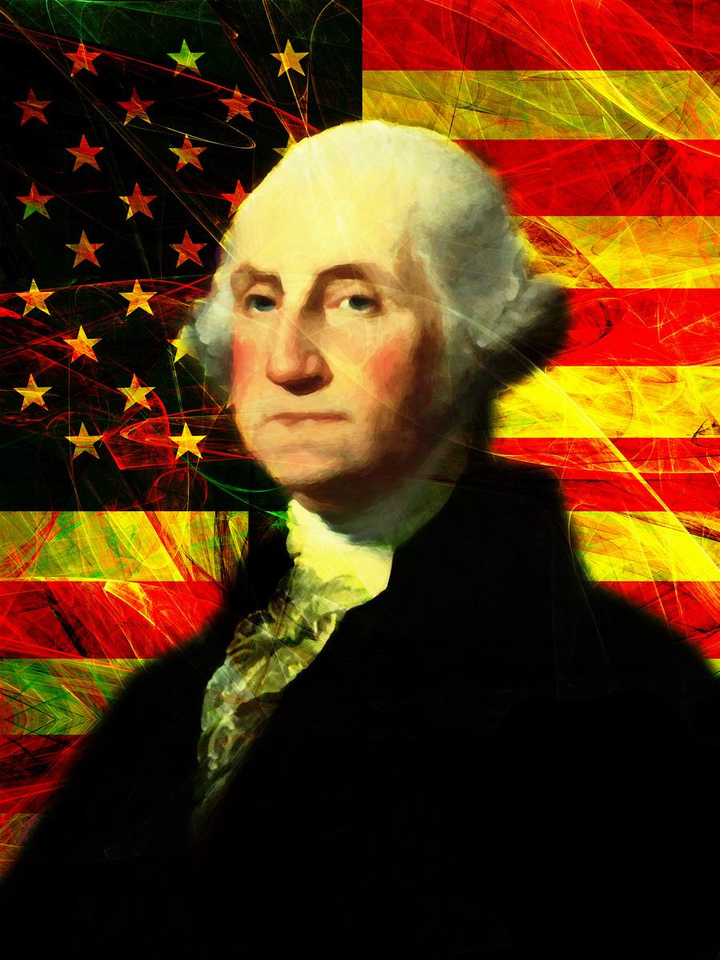
Mr. Answer Man Please Tell Us: Why Do Presidents Get Libraries?
“A Presidential library is constructed with private or non-Federal funds donated to non-profit organizations established usually for the express purpose of building a Presidential library and supporting its programs.”
Before the creation of the first Presidential library, Presidential papers were not consistently being preserved in accessible locations for research.
National Archives
The Presidential library system formally began in 1939, when President Franklin Delano Roosevelt donated his personal and Presidential papers to the federal government. At the same time, Roosevelt pledged part of his estate at Hyde Park, New York to the United States, and friends of the President formed a non-profit corporation to raise funds for the construction of the library and museum building. Roosevelt's decision stemmed from his belief that Presidential papers were an important part of the national heritage and should be accessible to the public. He asked the National Archives to take custody of his papers and other historical materials and to administer his library.
In 1950, Harry S. Truman decided that he, too, would build a library to house his Presidential papers and helped to galvanize congressional action.
Presidential Libraries Act of 1955
In 1955, Congress passed the Presidential Libraries Act of 1955, establishing a system of privately erected and federally maintained libraries. The Act encouraged other Presidents to donate their historical materials to the government and ensured the preservation of Presidential papers and their availability to the American people. Under this and subsequent acts, nine more libraries have been established. In each case, funds from private and non-federal public sources provided the funds to build the library. Once completed, the private organization turned over the libraries to the National Archives and Records Administration to operate and maintain.
Until 1978, Presidents, scholars, and legal professionals held the view dating back to George Washington that the records created by the President or his staff while in office remained the personal property of the President and were his to take with him when he left office. The first Presidential libraries were built on this concept. NARA successfully persuaded Presidents to donate their historical materials to the federal government for housing in a Presidential library managed by NARA.
Presidential Records Act of 1978
The Presidential Records Act of 1978 established that the Presidential records that document the constitutional, statutory, and ceremonial duties of the President are the property of the United States Government. After the President leaves office, the Archivist of the United States assumes custody of the records. The Act allowed for the continuation of Presidential libraries as the repository for Presidential records.
Presidential Libraries Act of 1986
The Presidential Libraries Act of 1986 also made significant changes to Presidential libraries, requiring private endowments linked to the size of the facility. NARA uses these endowments to offset a portion of the maintenance costs for the library.
National Archives.gov
• Mentalfloss
• Quora
• Wikipedia
• Presidential Library (YouTube) 
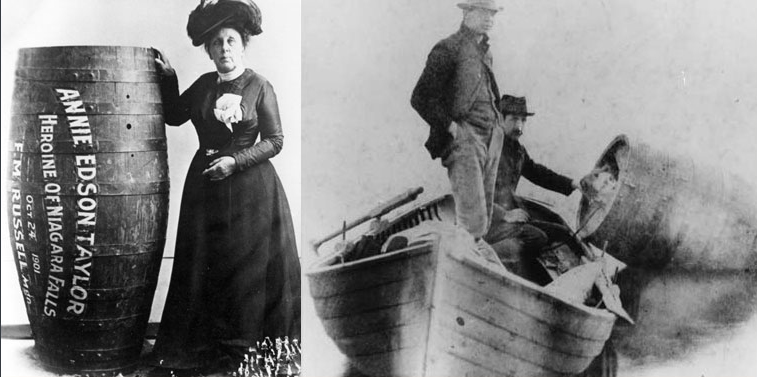
Where Did That Saying Come From?

“Over a barrel:” In the days before CPR a drowning victim would be placed face down over a barrel and the barrel would be rolled back and forth in a effort to empty the lungs of water. It was rarely effective. If you are over a barrel you are in deep trouble.
Phrases.org.UK

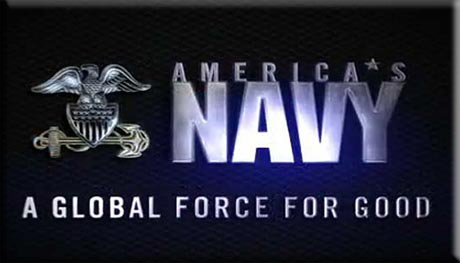
NAVSPEAK aka U.S. Navy Slang
Pier 20: Derogatory term used to describe the U.S.S. Mt. Whitney (LCC-20), as it rarely goes to sea.
PIERPAC: Pretending to be on deployment while moored to a pier. (like WESTPAC referring to a Western Pacific deployment.) See Fast Cruise.
Pier-Queer: Air Force term for “Sailor”. (The Navy term for Air Force personnel is simply “Queer”.)
Pier tender: A ship that never gets under way. See “USS Neversail”.


Just for you MARINE
Ranks: here are no acceptable contractions or shortened ways of addressing the following: Private, Lance Corporal, Corporal, Sergeant, Staff Sergeant, Sergeant Major,
Warrant Officer/Chief Warrant Officer, Major, Colonel, and General.
The following may be addressed with permission or informally:
Private First Class as PFC, a Gunnery Sergeant as “Gunny”, a Master Sergeant as “top”, a Master Gunnery Sergeant as “Master Gunny” or “Master Guns”,
a Second Lieutenant or First Lieutenant as “Lieutenant”, a Captain as “Skipper”,
a Lieutenant Colonel as “Colonel”, and a Brigadier General, Major General, and Lieutenant General as “General”. It is inappropriate to abbreviate an enlisted Marine's rank (Staff Sergeant or above) as “Sergeant”, nor can the nickname “sarge” be used. Appropriate written abbreviations for all ranks can be found on United States Marine Corps rank insignia.
Ratfuck: Taking the best available selection and leaving less desirable alternatives for others.
Rifle Combat Optic: Rifle Combat Optic, optical sight issued for use with the M16A4 service rifle. or M4 carbine; see also Advanced Combat Optical Gunsight.

Naval Aviation Squadron Nicknames
VAQ-131 - “Lancers”
Formerly VP-920, VP-ML-70, VP-931, VP-57, VAH-4 CVW-8, Naval Aviation Squadron Whidbey Island Oak Harbor, Washington - Established May 1, 1946

Science & Technology

Scientists Figure Out the Sun's Mysterious "Stealth" Explosions
• The Planes of Air Force Special Ops
• Microsoft's New Real-World Search Engine Is Incredible and Horrifying
• When Their Powers Combine, 5 Telescopes Can Bring You This Amazing Shot of the Crab Nebula
• Crushing Cars Is Just One Part of the Army's Strong Tank Challenge
• MIT's New Robot Can Teach Its Metallic Kin
Popular Mechanics

The Strange, Mysterious or Downright Weird
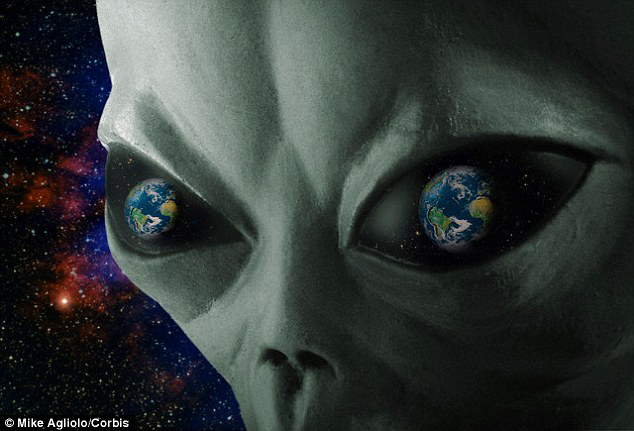
Film director Ridley Scott, who delights in terrifying moviegoers with his cinematic blend of horror and science fiction, suggested in a recent interview that the scary prospect of belligerent invading aliens might transcend the realm of sci-fi. According to Scott, hundreds of alien species are "out there" on distant worlds, and Earth's inhabitants should prepare for the worst if they ever decide to visit our planet.
One scientist, though, says that Scott's information about such hostile, and abundant, aliens is off-base and unsupported.
Scott told Agence France-Presse (AFP) about his belief in "superior beings," while fielding questions about his latest movie, "Alien: Covenant," opening in theaters in the U.S. on May 19. He warned that any extraterrestrial travelers who are technologically advanced enough to show up on our doorstep would likely be very intelligent and very hostile. And unlike the scenarios that dominate movies — if we go toe-to-toe with these invaders, we probably won't be the victors, he said.
“If you are stupid enough to challenge them you will be taken out in three seconds”, Scott told AFP. [Greetings, Earthlings! 8 Ways Aliens Could Contact Us]
The possibility of intelligent, technologically adept alien life has intrigued science-fiction writers and readers since the French writer Voltaire published his short story "Micromégas" in 1752, describing two extraterrestrial visitors to Earth — one from the planet Saturn and one from a planet orbiting the star Sirius.
Scott's “expert” estimate of 100 to 200 "entities" is entirely unsubstantiated, Shostak told Live Science.
Estimates based on data about known planets and galaxies suggest that the actual number of intelligent extraterrestrial life forms could, in fact, be significantly higher. With approximately 1 trillion planets in our galaxy alone, and about 2 trillion more galaxies, that adds up to…well, it's a lot of planets, Shostak said. [Why Do We Imagine Aliens as 'Little Green Men'?]
To narrow the search a bit, scientists could start by just looking at the trillion planets in our own galaxy, he said. Only a fraction of those planets might be capable of supporting life — perhaps 1 in 10. And maybe only 1 in 1,000 could produce and support life more complex than bacteria, he said.
That gives us about a billion planets in our galaxy that might harbor some type of intelligent life. But over time, life on many of those planets could have already waxed and waned — self-destructed or been wiped out. Perhaps only one planet in a million of those intelligent-life-harboring worlds still support life capable of contacting humans. That adds up to about 1,000 planets that could potentially hold intelligent, extraterrestrial species, Shostak told Live Science.
Live Science (05/02/2017) 


SONG FACTS

“Walk On The Wild Side” - Lou Reed
Album: Transformer
Released 1972 
This song is about cross-dressers who come to New York City and become prostitutes. “Take a walk on the wild side” is what they say to potential customers. Each verse introduces a new character. There is Holly, Candy, Little Joe, Sugar Plum Fairy, and Jackie. The characters are all cronies of the infamous Andy Warhol Factory, as was Lou.
Reed had an empathy for these characters that comes through in the song, as he struggled with his sexuality for most of his life. His parents even tried to “cure” his homosexuality when he was young.
“Little Joe” refers to Joe Dallesandro, who was also one of Andy's kids in the factory. He was in several films by Warhol. Sugar Plum Fairy is the nickname of actor Joe Campbell.
“Holly”, “Candy”, and “Jackie“ are based on Holly Woodlawn, Candy Darling, and Jackie Curtis. They are all real drag queens who appeared in Warhol's 1972 movie Women In Revolt. Woodlawn also appeared in Warhol's 1970 movie Trash, and Curtis was in Warhol's 1968 movie Flesh.
Said Reed: “I always thought it would be kind of fun to introduce people to characters they maybe hadn't met before, or hadn't wanted to meet.”
In a 1972 interview with Disc and Music Echo, Reed described this as an “outright gay song”, saying it was “from me to them, but they're carefully worded so the straights can miss out on the implications and enjoy them without being offended. I suppose though the album is going to offend some people.”
Reed recorded this two years after leaving The Velvet Underground, a band that was very influential, but not commercially successful. Transformer was Reed's second solo album. His first album flopped, and for a while it looked like his music career was over.
David Bowie and Mick Ronson produced this track. They were big fans of Reed.
The sax solo at the end was played by Ronnie Ross, a Jazz musician who lived near Bowie in England. When Bowie was 12 years old, he wanted to learn the saxophone and begged Ross to give him lessons, which he eventually did. When they needed a sax player for this, Bowie made sure Ross was booked for the session, but didn't tell him he'd be there. Ross nailed the solo in one take and Bowie showed up to surprise his old friend.
This came out at a time when audiences were intrigued by cross-dressing and homosexuality in music. “Glam Rock”, where the performers wore feminine clothes, was big, and artists like David Bowie and Elton John were attracting fans both gay and straight.
The famous bass line was played by a session musician named Herbie Flowers. He was paid 17 Pounds for his work. Flowers was modest about his contribution to this and other songs. He once told Mojo writer Phil Sutcliffe about his role as a session musician, “You do the job and get your arse away. You take a £12 fee, you can't play a load of bol--cks. Wouldn't it be awful if someone came up to me on the street and congratulated me for Transformer.”
The female vocalists singing backup on this track were Karen Friedman, Dari Lalou and Casey Synge. In 1974, they recorded as “Thunderthighs” and had a UK hit with “Central Park Arrest”.
Marky Mark's second single, after “Good Vibrations”  , was a remake of this called “Wildside”
, was a remake of this called “Wildside”  . He is now known as Mark Wahlberg and famous for movies like Boogie Nights and Rock Star.
. He is now known as Mark Wahlberg and famous for movies like Boogie Nights and Rock Star.
Reed's musical influence extends to Third Eye Blind: they got the idea for the doot doot doot hook on their hit “Semi-Charmed Life” from this song.
Lou Reed, official website / Billboard / All Music / Song Facts / Ultimate Classic Rock / Wikipedia
Image: “Transformer (album)” by Lou Reed
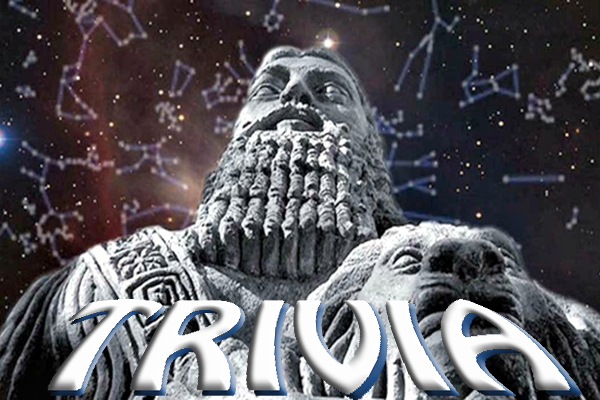
Trivia
Babylonian mathematicians were first to divide the day into 24 hours and the year into 360 days.
● After Chinese, the world's three most commonly spoken languages are English, Hindustani (Hindi and Urdu), Spanish.
● On July 25, 1898, the United States invaded Puerto Rico.
● The Americans call it the English Channel. The English call it the Channel. The French call it La Manche.

A Test for People Who Know Everything
From the Jeopardy Archives Category - “"DANGEROUS” ($200):
In 1604 King James I called this plant “dangerous to the lungs”.
● Answer for People Who Do Not Know Everything, or Want to Verify Their Answer National Park Service
Answer to Last Week's Test
From the Jeopardy Archives Category - “"A"DJECTIVES” ($200):
It can mean “full of life”, or describe characters like Rocky & Bullwinkle.
Answer: Animated. Wikipedia

Joke of the Day
Told in the 19th century
Paddy, newly arrived from Ireland, attends his first confession in New York. “What sins have you come to confess?” the priest asks.
“Ah, Father”, Paddy replies, “’Tis a terrible thing I’ve done. Blighted fair womankind, I have.”
“That is a serious sin, Paddy”, the priest replies. “Who was the woman?”
“Now, Father, I couldn’t tell you that”, Paddy replies. “It would be like betraying her all over again.”
“Only a full confession will cleanse you of your sin”, the priest admonishes. “And everything you tell me will be held in strictest confidence. So come on now — was it Mary from the Five Points?”
“Father, please don’t ask me.”
“Well, was it Kathleen from Hell’s Kitchen?”
“Father, I just can’t say.”
“Was it Sheila from Ninth Avenue?”
“No, no - I can’t speak her name, Father.”
The priest sighs. “Very well. Say three Hail Marys and put $2 in the collection box.”
“Thank you, Father, thank you”, Paddy says as he rises to leave. “Oh, and Father - thanks for all the good tips!”

“Mad Men” TV Series (2007 - 2015)
Don Draper: “Advertising is based on one thing: happiness. And do you know what happiness is? Happiness is the smell of a new car. It's freedom from fear. It's a billboard on the side of a road that screams with reassurance that whatever you're doing is OK. You are OK.”
(Series 1, Episode 1)
Don Draper: “It's your job. I give you money, you give me ideas.”
Peggy Olson: “And you never say thank you.”
Don Draper: “That's what the money is for!”
(Series 4, Episode 7)
Don Draper: “It wasn't a lie, it was ineptitude with insufficient cover.”
(Series 1, Episode 3)
~ “Mad Men” TV Series (2007 - 2015) - “YouTube search” (“Mad Men - TV series”)  Created by: Matthew Weiner
Created by: Matthew Weiner




























